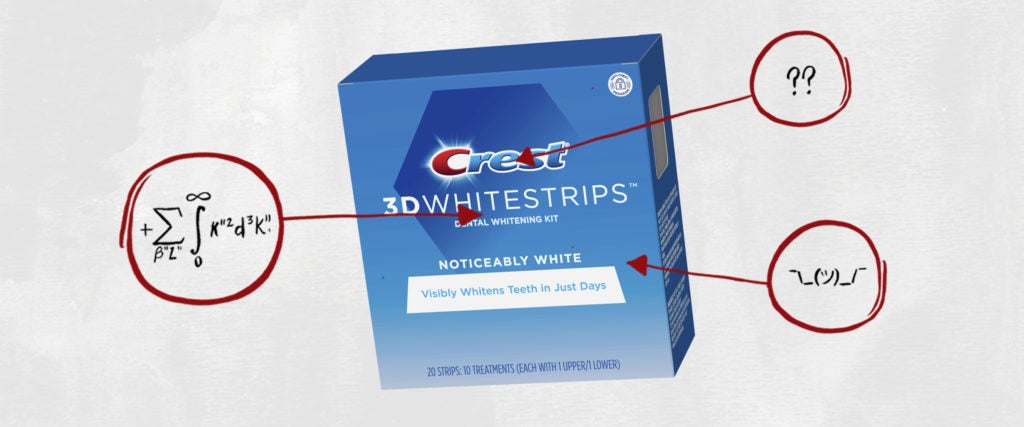We’re often told that you should never eat anything (or put anything on your body) if you don’t recognize everything on the ingredients list. But since most of us have no idea what xanthan gum or potassium benzoate are — or more importantly, what they’re doing to our bodies — we’re decoding the ingredients in the many things Americans put in (and on, or near) themselves.
This edition: Crest 3D White Whitestrips, which are made from 10 separate ingredients that we’ve broken down as they appear on the Crest website. (Note that the strips themselves are made from polyethylene, the most common plastic in use today, which doesn’t appear on the list below.)
The Ingredients
1) Water: Water is included in these whitening strips to prevent another ingredient, carbomer, from dehydrating your teeth. More on that in a moment.
2) Glycerin: Glycerin is a byproduct during the production of soap from animal fats, as well as the making of biodiesel from plant oils. It acts as a humectant — that is, it helps retain moisture — and makes the whitening gel sticky so it adheres to your teeth.
3) Hydrogen Peroxide: Hydrogen peroxide is a common bleaching ingredient in whitening strips. When it comes into contact with your teeth, it oxidizes, making surface stains look a whole lot whiter. If left on your teeth for too long, however, hydrogen peroxide can cause enamel breakdown and tooth sensitivity, so make sure to follow the instructions on the packaging.
4) Carbomer: Carbomer is a term used for a series of polymers usually made from acrylic acid, which all sounds science-y, but it basically works in whitening strips as an adhesive gel. That adhesion can dry out your teeth, though, which is where a little bit of water in these strips helps keep everything happy and moist.
5) Polyvinylpyrrolidone (PVP): Polyvinylpyrrolidone (I have no idea what I just typed) is another adhesive polymer, known for its inclusion in glue sticks, batteries and paints. (Don’t worry: Dentists say it’s safe.) It absorbs moisture, which can result in some tooth sensitivity, but if you follow the instructions and produce a normal amount of saliva, you should be just fine.
6) PEG: PEG, or polyethylene glycol, works as a humectant, similar to glycerin. It basically makes the whitening gel thicker and more adhesive by binding to the water in your saliva, creating a sticky layer of whitening goodness.
7) Acrylates Copolymer: Acrylates copolymer is a general term for synthetic copolymers, which again sounds really science-y, but this basically serves to keep the strip in one piece during use.
8) Sodium Hydroxide: Also known as lye, sodium hydroxide is used as a pH adjuster, making the strips less acidic so you can keep them in your mouth. It’s also found in, uh, bleach. It’s considered toxic when used inside the body, so that’s not good.
9) Sodium Saccharin: Sodium saccharin is the solid form of an artificial sweetener called saccharin, and it basically makes these strips taste somewhat tolerable. During the 1970s, controversial studies performed on rodents found the ingredient to be carcinogenic, though subsequent studies on both people and primates found that saccharin was indeed safe for human consumption. One of those studies, published in the Journal for the National Cancer Institute in 1998, found that primates exposed to saccharin, even on a daily basis from birth, showed no adverse effects.
10) Pyrophosphate: Pyrophosphate is made naturally by the human body and prevents calcification, stopping tartar crystals from building on top of your teeth.
The Takeaway
While a few of these ingredients — sodium hydroxide, hydrogen peroxide, polyvinylpyrrolidone — sound like the opposite of what you should be putting in (or near) your mouth, dentists themselves generally say that whitening strips and the compounds in them are totally safe. Then again, some research suggests that whitening strips can at the very least damage your teeth. So all in all, whiten with caution.


